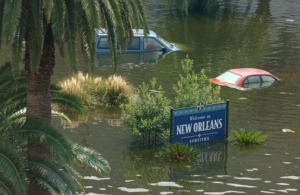Hurricane Katrina
There were so many stories playing out in the battered areas of Hurricane Katrina that there just isn't enough room to do them all justice so I'll just try to hit on some high points. We took off for Louisiana on Thursday, September 1st meeting up with Kay Mayfield from United Animal Nations (UAN) and Shirley Minchew from the International Fund for Animal Welfare (IFAW) in Houston.
We took off to assist the Houston SPCA with setting up a satellite receiving area. Their present shelter was nearly at capacity and they knew they would be taking in hundreds of animals that were displaced by Katrina. The first day was spent receiving literally tons of donations from the Houstonians. Those folks in the south really know what it means to give from the heart. Much of those supplies were then transported to the satellite receiving area and stored for the future inhabitants. We then headed for Monroe Louisiana where we were to meet up with Warren "Chief" Craig from Code 3 Associated. Code 3 Associates is a rapid response disaste team that specializes in animal rescues. They are based in Longmont Colorado. Our team departed company with UAN and headed for Gonzales, La. UAN continued on to Mississippi where they opened up yet another receiving area. In Gonzales, La, is the Lamar Dixon Expo. Similar to the Del Mar Fairgrounds only with much larger and open buildings, hundreds of volunteers from all over the country started to converge to turn thee otherwise empty grounds into the countries largest evacuation center. Behind shed 3 was B.A.R.T. (Big Animal Rescue Truck). This is a 77 foot tractor trailer rig which sleeps 8, has an operating room, 12 built in kennels, kitchen area, office, bathroom, carries a truck and a horse trailer, 3 boats and all the necessary gear, protable horse corrals, 360 gallons of water, enough provisions for both man and animal to be self sufficient for a week, and gets 4.5 miles to the gallon. This was home for the next week and a half. 5:30 rolls around pretty early as Chief gets everyone up and ready for the days work. A briefing takes place early every morning as we try to down a quick breakfast and get on the road. New Orleans is about 50 miles south of Gonzales down I-10. This trip alone is a story as every conceivable emergency vehicle is trying to get into town at the same time. There were police, ambulance, electric and telephone companies, relief groups and, of course only one animal rescue group. The first couple of days were spent in the Garden District.
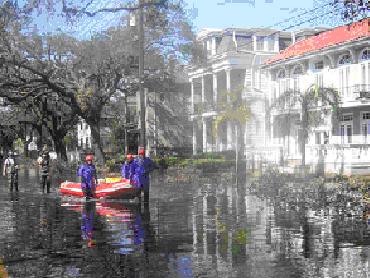
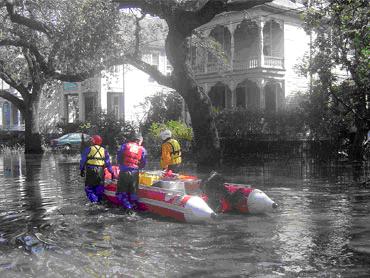
This was a very well to do neighborhood. Down Napoleon St past St Charles Ave. is where we would unload our boats and stage the transport vehicles. We had very specific addresses we were supposed to find and check for abandon animals. These addresses were sent to HSUS (Humane Society of the United States). As we found these addresses, we had permission to gain entry by whatever means necessary. That usually meant breaking a window or busting down a door. While motoring our Zodiac inflatable boat down one street, we came upon an elderly gentleman sitting on his porch. Porches in this area are anywhere from 8 - 10 feet off the ground with concrete steps leading up to them. When asked if he was alright he politely replied that he would very much like to leave. A quick radio call back to Chief sent the National Guard in with a Deuce and a Half truck to evacuate him. A very grateful man indeed. A very humbling experience for us. These trucks have tires that are nearly 6 feet tall and can traverse nearly anything, including a cesspool over your head. We came upon address after address with animals more then ready to abandon their homes they had been left in. Many of the owners had left large bags of food torn open and pots and pans of fresh water for their pets, not knowing the amount of flooding that would occur. We came upon another man who had several dogs in his care. He had a canoe but was unable to carry all his dogs in it.
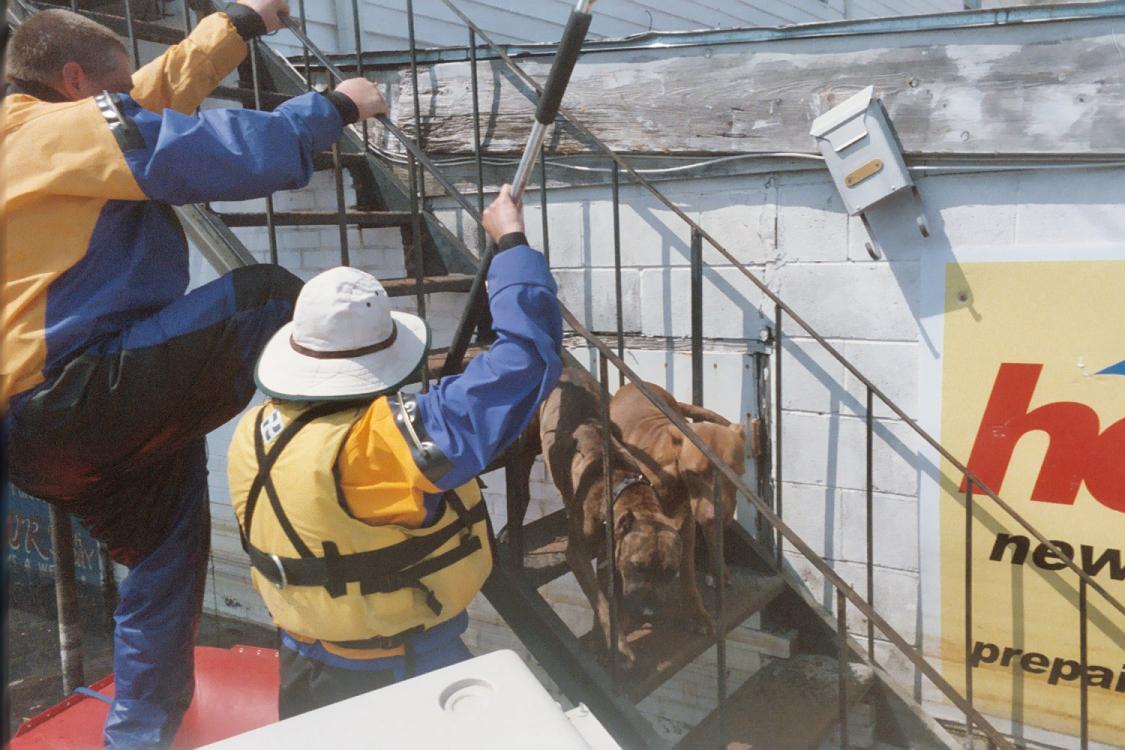
We had enough kennels for all but one when Goose, B.A.R.T.'s driver and our new team member, remembered seeing a large kennel several blocks back floating in a yard. Goose and I went back to look for the kennel and spotting it floating amongst the other debris went to retrieve it. When we got to it, I jumped into the water and waded over to it. Goose and I both looked at each other in hopes that it was empty. It was. I tipped it to empty the water and sewage that was in it and we got it on board the boat. When we arrived back at the house we loaded up the dogs and headed in with our load. When we got back we notified the Sheriff's about the man and they headed out to get him. As we headed back for our next run, we saw the man coming in with his canoe. He said he never saw the Sheriffs. He was very happy to see his dogs on dry ground. Our rescue missions all ended in very much the same way. A boat load full of dogs and some very grateful people.
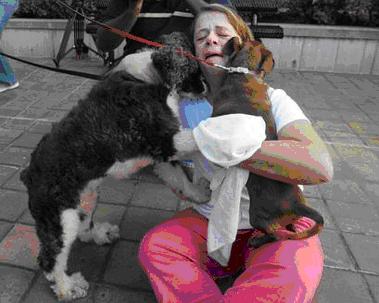
But one in particular got to me. We spotted a man on the third floor of a Junior High School building. He was frantically waving at us. We motored the boat up to the front door and had him come down to us. When he opened the front door, he had his Rottweiller with him. He fell to his knees and broke down. He told us that he had been there since the hurricane hit, nearly a week earlier. We got his dog Cisco into a kennel. He told us that there was a white Pit Bull that had also made its way to the school to seek shelter. He had it trapped in one of the classrooms. We contacted a National Guard helicopter and had the man airlifted off the roof. The helicopter's downdraft was nearly lifting the boat and all its contents off the water. Goose and I had to lie across the boat to keep it from flying off. The wind from the blades gave us a good idea of what it must have felt like during the hurricane as it was only 30-40 feet above us. We then set our sites on getting the trapped Pit Bull. We opened the door a bit to see if we could see any sign of the dog. Just to the left was a desk and the tip of the dogs tail. Goose used the catchpole to push the desk against the wall and force the dog out. He came out like a rocket so we slammed the door shut. The next thing we knew we saw the happiest Pit Bull in the world dancing at the classroom door. We opened the door and got the catchpole on him. There wasn't really a need for this other then to assist us in getting them into the kennel. Unfortunately, this dog didn't stop barking the entire rest of the day. But it was a happy bark so we really didn't mind.
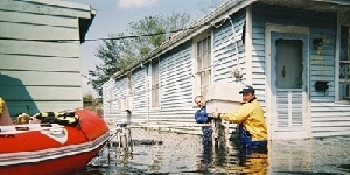
Our next area to search was a place where I-160 split off of the I-10. We went over a few hills and then the freeway went into the water. This is where we'd launch our boats. There were neighborhoods on either side and we had to weave around the overpasses to get into them. It was a particularly hot day with very high humidity. 95 degrees and 95 % humidity. We were all loaded up with kennels and headed into the neighborhoods. These again were very nice houses from well to do families. The kind that had the means to evacuate with their pets. We hardly saw any animals except for a Pit Bull on his last legs laying in the shallow water when we first pulled up and a Koi fish that was still swimming despite all the toxins in the water. There were, however, several refrigerated trucks and a pallet of body bags next to our staging area. You can figure it out from there. The next several days were spent in in an area where we had been told there were hundreds of animals left to fend for themselves. This area was called Elysian Fields. It was one of the more blighted areas of New Orleans. As we motored our rescue boats out into the neighborhoods we would just whistle and listen. Nearly each time we would hear a dog bark and all we had to do was track it down. One of the first ones we found was a small brown Poodle. The initial entry into this house consisted of Goose literally pulling the entire window frame from the wall as there were bars across the windows. We bent the catchpole back later. The dog was in the upstairs bathroom. He was tied to the shower with a long plastic coated cord and the toilet seat was left open for him to drink out of. The dog had wrapped itself around the base of the toilet enough times that he couldn't reach the toilet to get any water. Not that it would have done any good as all the sewer systems had backed up and overflowed in the houses. And this little guy wasn't going down without a fight. We had turned the kennel on its side with the door facing up. As I picked up the dog by the cord attached to his collar and got him over the kennel, he simply slipped out of the collar and fell right into the kennel. He has lost so much weight that he just fell out of his collar. Later that day we noticed a dog that was trapped on top of a roof.

A Doberman. We motored across the street (river) and tied up the boat and waded through chest deep water to the back yard. We looked for any way to get up to the roof. We went inside and found no access to the attic. There was a hole in the roof where the dog was entering through to get out of the sun. We couldn't find any ladder or other access to the roof so I found a vent pipe that was attached to the outside walls. The first 2 were made of PVC and would come off with a small pull. The third was made of steel and had some good braces holding it tightly to the wall. There was also a small gas line that I was able to get my toes on and use the vent pipe to climb halfway up the wall. Unfortunately, the eaves of the roof were keeping me from accessing the roof. Goose came over and told me to stand on his shoulders while he stood an the concrete steps outside the back door. This got my shoulders to the rooftop and I was able to lift myself the rest of the way onto the roof. The dog was trying to scramble back into the hole in the roof and I grabbed her just as her back legs were going in. She fought me the whole way. I was able to get her out of the hole and onto the roof. The attic must have been over 100 degrees inside and the roof was all black shingles. No matter where she went, it was hot. As I made my way down the steep slope of the roof, I was thinking of how we were going to get her down over the edge. It was about a 5 foot drop down to Goose. If I leaned over too far, we were both going into the drink. I had to lie on my stomach, get the dog to lie down and slide her over the edge and inch my way over the edge until my waist was in the gutters. I knew this was as far as I could go. Goose was able to reach up and grab her front legs. I told him I was going to let go of her hind end and he would have to swing her into his arms. It worked. When I got down I noticed that they had the dog over by the doorway drinking fresh water off a plate on top of a capsized refrigerator. This rescue alone made all the hard work and all the dangerous conditions worth every minute of it.
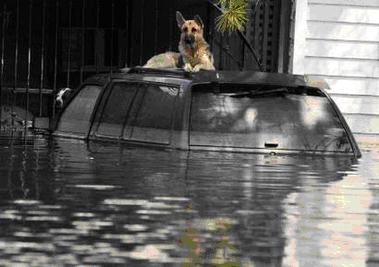
I could go on and on about the rescues that were like this. Most we got; a few we didn't. But that's the nature of disasters. You do what you can with every ounce of energy you have. And if that's not good enough, then you know how we felt each night going home. Maybe we could have gotten one more. Maybe if we had tried this or that. Maybe. But I know that our team, and the teams from IFAW and Code 3, gave everything we had to the animals and I'm very proud of what we did. There are now over 400 animals that have another chance at life. Many will not see their owners again, but will most likely be adopted by new families over the next few weeks, there will be a thousand new pets named Katrina.
